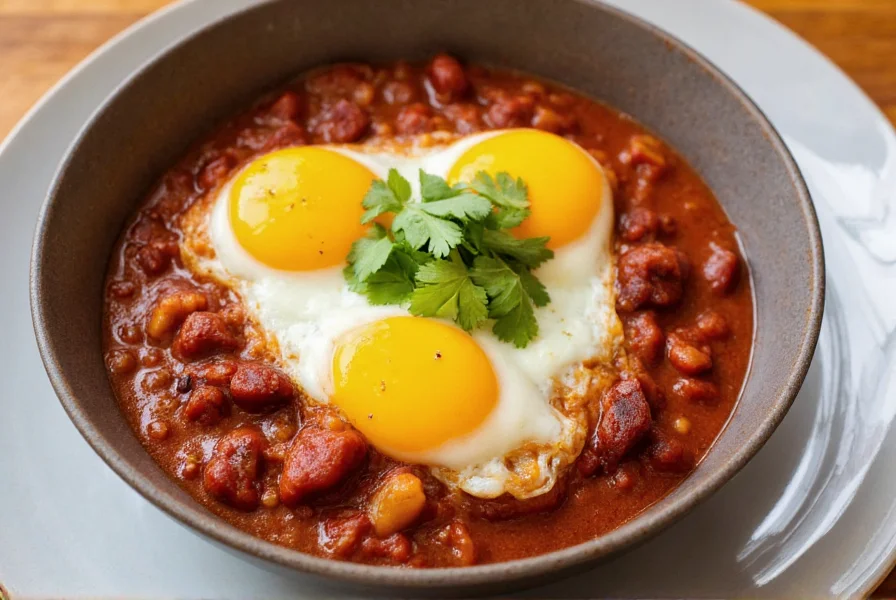
The Essential Guide to Perfect Chili and Eggs
Chili and eggs represent one of America's most satisfying comfort food combinations, particularly beloved in Southwestern and Tex-Mex culinary traditions. This versatile dish transforms simple ingredients into a hearty meal that works equally well for breakfast, brunch, or even dinner. Whether you're using leftover chili con carne or fresh chili peppers, understanding the proper technique ensures restaurant-quality results at home.
Understanding Chili Variations for Egg Dishes
Not all chili works equally well with eggs. The two primary approaches create distinctly different eating experiences:
| Chili Type | Best Egg Preparation | Flavor Profile |
|---|---|---|
| Chili con carne (meat-based) | Top with fried or poached eggs | Rich, savory, complex |
| Fresh chili peppers (jalapeño, serrano) | Scramble directly with eggs | Vegetal, bright, varying heat levels |
| Green chili (poblano-based) | Enchilada-style with melted cheese | Earthy, mild to medium heat |
Classic Chili con Carne and Eggs Recipe
Creating the perfect chili and eggs dish requires attention to both components. Follow these professional kitchen techniques for optimal results:
Ingredients
- 2 cups prepared chili con carne (homemade or quality canned)
- 4 large eggs
- 2 tablespoons whole milk or cream
- 1 tablespoon unsalted butter
- Salt and freshly ground black pepper to taste
- 2 tablespoons chopped fresh cilantro
- 1/4 cup shredded sharp cheddar or queso fresco
Step-by-Step Preparation
- Warm chili con carne in a skillet over medium-low heat until bubbling gently
- Prepare eggs by whisking with milk, salt, and pepper until just combined (don't overmix)
- Melt butter in separate non-stick skillet over medium-low heat
- Pour eggs into skillet and let sit for 20 seconds before gently folding
- Cook until softly set but still slightly moist (they'll continue cooking off heat)
- Spoon warm chili into serving bowl and top with eggs
- Finish with fresh cilantro and cheese

Regional Variations Worth Trying
Culinary traditions across North America have developed distinctive takes on chili and eggs:
Texas-Style Huevos con Chile
This version features coarse-ground beef chili with kidney beans served with runny-yolk fried eggs. The key technique involves creating a small well in the chili to cook the eggs directly in the sauce, allowing the yolk to mingle with the chili as it cooks.
New Mexico Green Chile Egg Skillet
Using roasted Hatch green chilies, this variation combines scrambled eggs with fresh green chilies, onions, and potatoes. Many New Mexican chefs add a splash of cream to create a richer texture that balances the chili's vegetal notes.
California Avocado Chili Egg Bowl
A modern interpretation featuring black bean chili topped with soft scrambled eggs, sliced avocado, and a squeeze of lime. This version works particularly well with vegetarian chili and provides a refreshing contrast to the spicy base.
Pro Tips for Perfect Chili and Eggs Every Time
Professional chefs recommend these techniques for elevating your chili and eggs preparation:
- Temperature control - Keep chili warm but not boiling when adding eggs to prevent overcooking
- Egg texture - For fried eggs, aim for runny yolks that create a natural sauce when broken
- Acid balance - A squeeze of fresh lime juice just before serving brightens rich chili flavors
- Texture contrast - Top with crunchy elements like fried onions or tortilla strips
- Heat management - When using fresh chilies, remove seeds and membranes for milder heat
Nutritional Benefits of This Power Combination
Chili and eggs create a nutritionally balanced meal when prepared thoughtfully. The combination delivers:
- Complete protein from both egg whites and chili meat or beans
- Healthy fats from egg yolks that aid nutrient absorption
- Fiber from beans and vegetables in quality chili recipes
- Essential vitamins including B12, A, and C depending on ingredients
For a lighter version, use turkey or chicken in your chili and opt for egg whites or a combination of whole eggs and whites. Adding vegetables like bell peppers or zucchini to your chili increases nutritional density without compromising flavor.
Frequently Asked Questions
Can I use canned chili for eggs dishes?
Yes, quality canned chili works well for egg dishes. Look for varieties with minimal additives and good meat-to-bean ratio. For best results, enhance canned chili by simmering with fresh garlic, a splash of beer or coffee, and additional spices before adding eggs.
What's the best way to prevent rubbery eggs with chili?
To avoid rubbery eggs, cook them separately from the chili using low heat. Remove eggs from heat just before they reach desired doneness, as residual heat will continue cooking them. When topping chili with eggs, the residual heat from the chili will finish warming the eggs without overcooking.
How do I make vegetarian chili and eggs?
Create vegetarian chili using black beans, kidney beans, or lentils as the protein base. Add mushrooms for meaty texture and depth. When preparing chili and eggs with vegetarian chili, consider adding a tablespoon of nutritional yeast to the eggs for umami flavor that mimics traditional meat-based chili.
What side dishes pair well with chili and eggs?
Traditional accompaniments include warm corn tortillas, flour tortillas, or crusty bread for dipping. For breakfast service, hash browns or roasted potatoes provide satisfying texture contrast. A simple green salad with lime vinaigrette offers refreshing balance to the rich, spicy main dish.
Can I meal prep chili and eggs for the week?
Yes, but store components separately. Prepare and refrigerate chili for up to 4 days. When ready to eat, reheat chili and top with freshly cooked eggs. Eggs don't store well pre-cooked for this application, as they become rubbery when reheated. For meal prep efficiency, keep hard-boiled eggs separate and slice them over warm chili just before serving.











 浙公网安备
33010002000092号
浙公网安备
33010002000092号 浙B2-20120091-4
浙B2-20120091-4